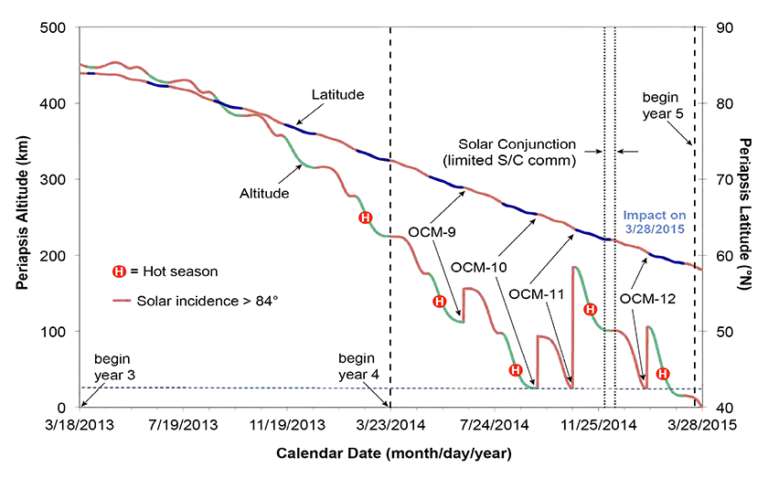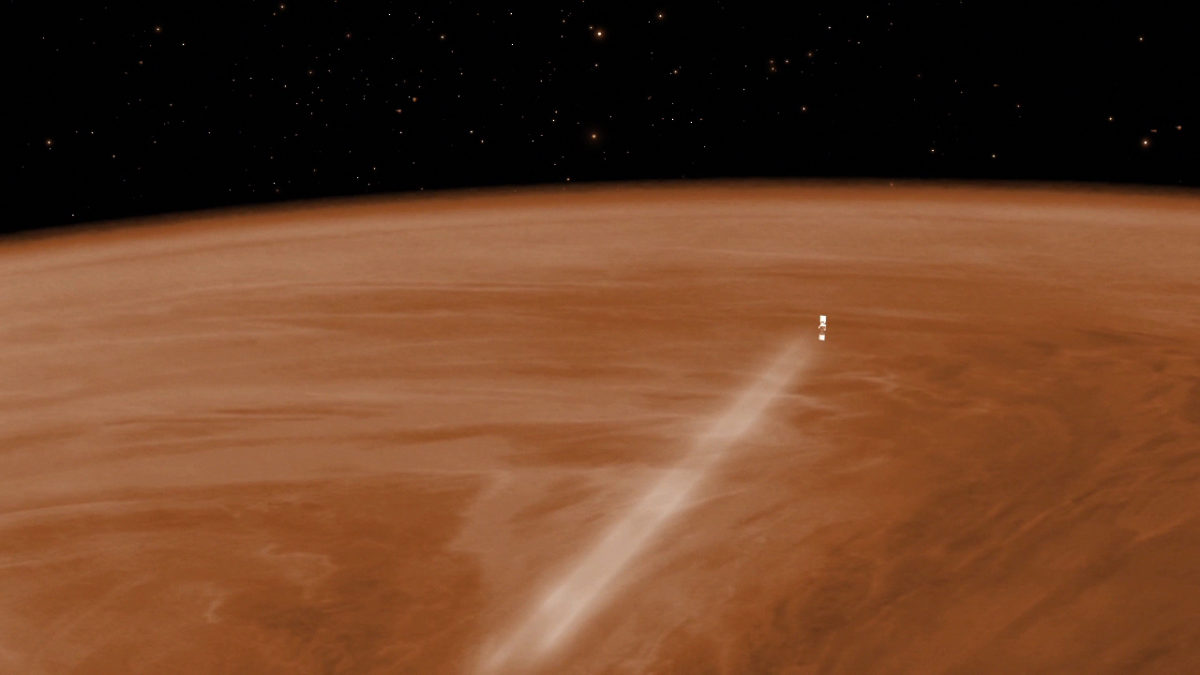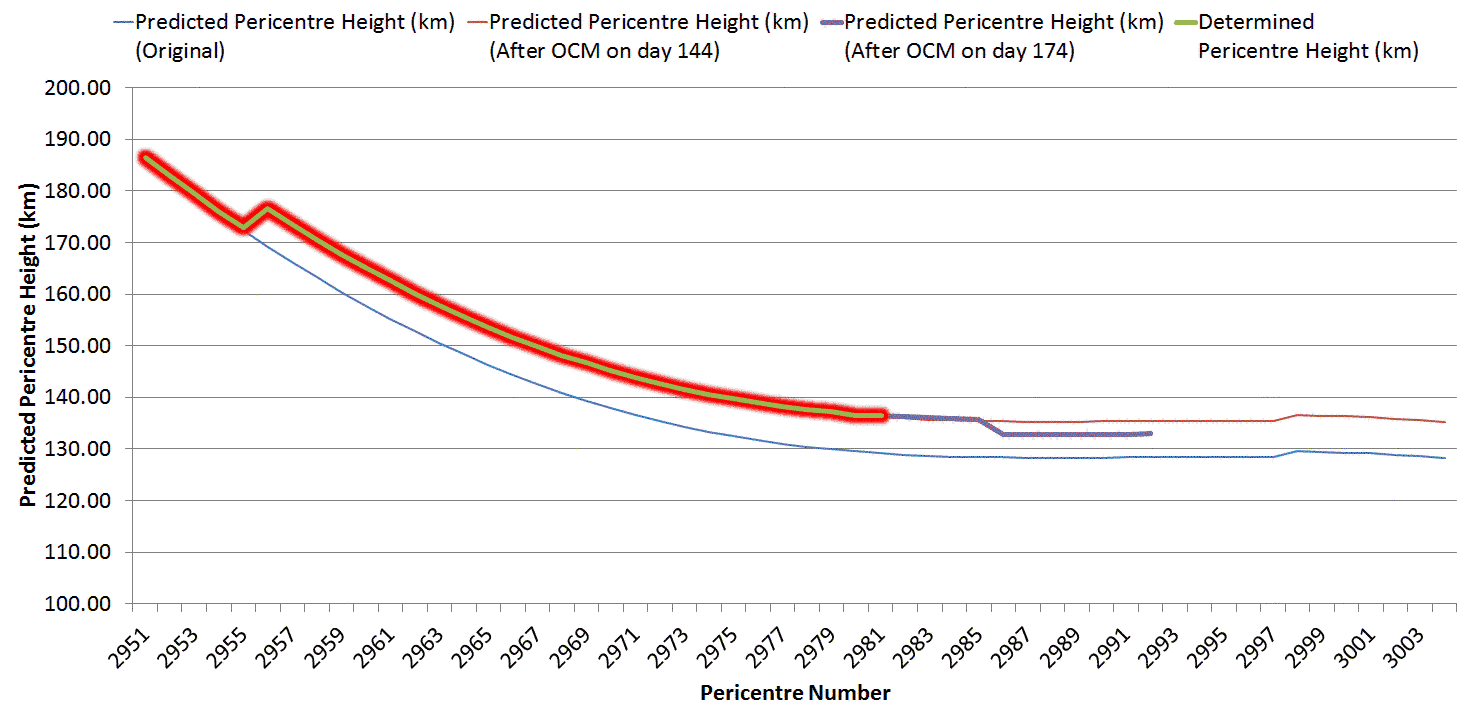Emily Lakdawalla • Jun 24, 2014
Skimming the inner planets: Updates on MESSENGER and Venus Express
The two spacecraft currently orbiting the two innermost planets are both flying low in their orbits in the final phases of their missions. MESSENGER just performed a rocket burn to raise its orbit slightly, while Venus Express did the opposite.
MESSENGER's orbit at Mercury needs fairly frequent maintenance because of the perturbing effects of the Sun's gravity. The orbit is nearly polar and highly elliptical, with a close approach a few hundred kilometers above the high northern latitudes. During MESSENGER's prime mission, the orbit tended to widen, lifting MESSENGER higher and higher above the pole, so their rocket burns worked to return the orbit periapsis to a lower position.
Since the first mission extension began in March 2012, MESSENGER has been flying substantially closer to Mercury, on an orbit with an 8-hour rather than a 12-hour period. Over time, they have brought the periapsis (closest approach point) closer and closer to Mercury's surface. With their closer orbit, they've been able to target interesting spots on Mercury for higher-resolution views than ever before, like this recent view of two colorful craters within the Caloris basin.

Because of a shift in the geometry of the orbit over time, MESSENGER's orbit behavior has changed; now, it tends to decay. Without rocket burns, the spacecraft will crash. So the end of MESSENGER is inevitable. But enough fuel remains to conduct one last year of very, very low altitude orbits. They have just conducted the first of a series of four rocket burns to lift the orbit periapsis temporarily, slowing its inevitable decay. Here's a graph of how MESSENGER's periapsis altitude will decrease with time. You can see that, over the course of this year, the orbit will decay to just 25 kilometers above the surface -- that's just about twice the altitude that a passenger jet flies over Earth. They will reboost the periapsis altitude three times, in September, October, and January. The bruns will use up MESSENGER's remaining fuel, and the spacecraft will crash on March 28, 2015.

Here's the schedule for rocket burns, and some interesting technical information from the MESSENGER website about the orbit correction maneuvers (OCMs):
| Maneuver | Calendar Date | ΔV (m/s) | Purpose |
|---|---|---|---|
| OCM-9 | 17 June 2014 | 5.0 | Target 25-km minimum altitude on 12 September 2014 |
| OCM-10 | 12 September 2014 | 8.5 | Target 25-km minimum altitude on 24 October 2014 |
| OCM-11 | 24 October 2014 | 19.3 | Target 25-km minimum altitude on 21 January 2015 |
| OCM-12 | 21 January 2015 | 9.7 | Target 15-km minimum altitude on 1 March 2015 |
In December 2014 the spacecraft will experience a prolonged period when the Sun’s presence between Earth and Mercury (called solar conjunction) will degrade or prevent communication with the spacecraft. Although additional solar conjunctions occur during the final two years of flight operations, the December 2014 solar conjunction is shown since it prevented OCM-11 [Orbit Correction Maneuver 11] from targeting a period when minimum altitude would remain near 25 km. In the figure below the red highlighted portions of each line, which denote solar incidence angle > 84°, indicate when the night side of Mercury limits opportunities to image much of Mercury’s surface. Labels such as “begin year 3” in the figure below measure the time elapsed, in Earth years, since the start of the spacecraft’s first orbit around Mercury.
The 26 months from OCM-8 on 20 April 2012 to OCM-9 on 17 June 2014 is the longest time between orbit-altering propulsive maneuvers during the MESSENGER mission. Each OCM after OCM-8 not only raises periapsis altitude, but also increases orbit period – such that the time for each orbit of Mercury increases from 8h 0m before OCM-9 to 8h 17m after OCM-12. Each OCM targets a minimum altitude relative to the highest surface feature of 25 km after OCM-9, -10, and -11 and 15 km after OCM-12. The propellant depletion strategy during the final four OCMs includes exhausting nearly all remaining usable propellant in the second main fuel tank (OCM-10) and drawing nearly all of the estimated usable fuel from the auxiliary fuel tank (OCM-9, OCM-11, and OCM-12).

Venus Express
Meanwhile, Venus Express is actively lowering its periapsis altitude, part of its ongoing aerobraking campaign. They posted an informative update a couple of days ago, written by Venus Express science operations coordinator Colin Wilson with help from people at the European Space Operations Centre, which I'll share here:
As the aerobraking campaign - in which Venus express spends part of each orbit deep in the atmosphere - continues, the altitude of the spacecraft has been decreasing naturally due to gravitational forces. Its orbit is now such that its altitude at pericentre passage - the point of lowest approach over the planet's surface - is well below 140 km – much lower than ever before.
This means that the spacecraft is now so low that it experiences significant drag due to the atmosphere; this drag can be measured by the spacecraft accelerometers, giving measurements of atmospheric density. We are currently experiencing dynamic pressures of 0.13 N/m^2, predicted to grow to 0.20 N/m^2 as the pericentre altitude decays further.
However, we think Venus Express can handle significantly higher atmospheric densities, and we want to probe the atmosphere even lower and discover how the spacecraft performs at higher dynamic pressures, ranging as high as 0.4 to 0.6 N/m^2.
Therefore, the mission operations team at ESOC used the spacecraft's thrusters today to lower the pericentre altitude by 2.8 km; this pericentre-lowering manoeuvre (think of it as a 'push-down' manoeuvre) was done by firing the thrusters as Venus Express passed through apocentre. The thruster burn took place at 12:42 CEST (10:42 UTC), and the next - and unprecedented low - pericentre pass will now occur at 00:31 CEST on 24 June (22:31 UTC on 23.06). The manoeuvre should bring pressures to 0.4 N/m^2 by the mid-point of the aerobraking plateau on 29 June.
We are in unknown territory, and we're going in deeper.
Currently, the lowest altitude experienced is on the daylit side of the planet. But next week, it will cross over onto the nightside of the planet, when we expect atmospheric densities to drop significantly (but by an unknown amount). At that time, we may be able to perform another pull-down manoeuvre.
As mentioned, we can now definitely see drag due to the atmosphere in our accelerometer data; the chart below shows the accelerometer trace measured during one orbit.
In addition to showing a peak in the accelerations when the spacecraft reaches its minimum altitude, small oscillations can be seen. These are due to variations in the atmospheric density along the flight path. Scientists are looking forward to comparing the properties of these waves with those observed lower done using radio occultation and using VEX' camera
More details later as this fantastic spacecraft continues charting uncharted territory!
Once MESSENGER and Venus Express crash into their respective planets, we will no longer have any missions actively exploring the inner planets. Akatsuki is still on its way and might possibly manage to enter orbit at Venus in late 2015. The next inner solar system mission is BepiColombo, which is making progress toward its 2016 launch; it will fly by Venus on its way to a 2023 arrival at Mercury. They announced this week that the spacecraft has finished testing at Thales Alenia, and will soon be shipped to ESTEC in Noordvijk for launch testing.
The Time is Now.
As a Planetary Defender, you’re part of our mission to decrease the risk of Earth being hit by an asteroid or comet.
Donate Today

 Explore Worlds
Explore Worlds Find Life
Find Life Defend Earth
Defend Earth


